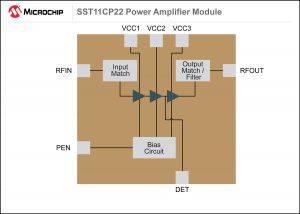Microchip’s New 5 GHz Power Amplifier Module Extends the Range and Reduces Production Costs of WLAN Applications Based on IEEE 802.11ac Wi-Fi® Standard
Microchip Technology Inc., a leading provider of microcontroller, analog and Flash-IP solutions, today announced its newSST11CP22 5 GHz power amplifier module (PAM) for the IEEE 802.11ac ultra high data rate Wi-Fi® standard. This PAM delivers 19 dBm linear output power at 1.8% dynamic EVM (Error Vector Magnitude) with MCS9 80 MHz bandwidth modulation. Additionally, the SST11CP22 delivers 20 dBm linear power at 3% EVM for 802.11a/n applications, is spectrum mask compliant up to 24 dBm for 802.11a communication, and has less than – 45 dBm/MHz RF harmonic output at this output power, making it easier for the system board to meet FCC regulations.
 Achieving the maximum data rate and longest range while minimizing current consumption is essential to Wi-Fi MIMO access-point, router and set-top-box system designers. The SST11CP22’s low EVM and high linear power facilitate MIMO operation and significantly extend the range of 802.11ac systems in ultra-high data rate transmission mode. The module, housed in a space-saving 4×4 mm, 20-pin QFN package, includes an output harmonic rejection filter and is 50 Ohm-matched—requiring only four external components. It is easy to use and reduces board size. Additionally, the integrated linear power detector provides accurate output power control over temperature and 2-to-1 output mismatch. These features are critical for 802.11ac Wi-Fi set-top boxes, routers, access points and wireless video streaming devices that operate at high data rates.
Achieving the maximum data rate and longest range while minimizing current consumption is essential to Wi-Fi MIMO access-point, router and set-top-box system designers. The SST11CP22’s low EVM and high linear power facilitate MIMO operation and significantly extend the range of 802.11ac systems in ultra-high data rate transmission mode. The module, housed in a space-saving 4×4 mm, 20-pin QFN package, includes an output harmonic rejection filter and is 50 Ohm-matched—requiring only four external components. It is easy to use and reduces board size. Additionally, the integrated linear power detector provides accurate output power control over temperature and 2-to-1 output mismatch. These features are critical for 802.11ac Wi-Fi set-top boxes, routers, access points and wireless video streaming devices that operate at high data rates.
“Microchip’s RF power amplifiers have a strong position in the WLAN market, due to their reliability combined with high-power efficiencies that can only be achieved using InGaP/GaAs HBT,” said Daniel Chow, vice president of Microchip’s Radio Frequency Division. “The release of the SST11CP22 now provides the same reliable operation with extra low EVM, ease of use, and low harmonic emission. This new PAM will extend the range and  reduce the production costs of ultra-high data rate 802.11ac systems.”
reduce the production costs of ultra-high data rate 802.11ac systems.”
